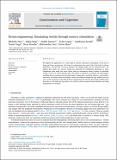Dream engineering: Simulating worlds through sensory stimulation
Author(s)
Carr, Michelle; Haar, Adam; Amores, Judith; Lopes, Pedro; Bernal, Guillermo; Vega, Tomás; Rosello, Oscar; Jain, Abhinandan; Maes, Pattie; ... Show more Show less
DownloadPublished version (5.196Mb)
Publisher with Creative Commons License
Publisher with Creative Commons License
Creative Commons Attribution
Terms of use
Metadata
Show full item recordAbstract
© 2020 The Authors We explore the application of a wide range of sensory stimulation technologies to the area of sleep and dream engineering. We begin by emphasizing the causal role of the body in dream generation, and describe a circuitry between the sleeping body and the dreaming mind. We suggest that nearly any sensory stimuli has potential for modulating experience in sleep. Considering other areas that might afford tools for engineering sensory content in simulated worlds, we turn to Virtual Reality (VR). We outline a collection of relevant VR technologies, including devices engineered to stimulate haptic, temperature, vestibular, olfactory, and auditory sensations. We believe these technologies, which have been developed for high mobility and low cost, can be translated to the field of dream engineering. We close by discussing possible future directions in this field and the ethics of a world in which targeted dream direction and sleep manipulation are feasible.
Date issued
2020Department
Massachusetts Institute of Technology. Media LaboratoryJournal
Consciousness and Cognition
Publisher
Elsevier BV